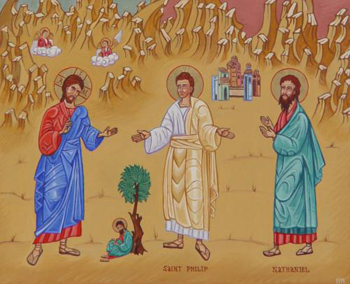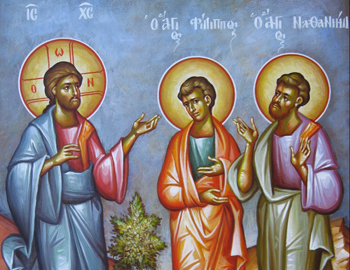For Sunday January 14, 2018
Lectionary Readings (Revised Common Lectionary, Year B)
1 Samuel 3:1-20
Psalm 139:1-6, 13-18
1 Corinthians 6:12-10
John 1:43-51
“What would Jesus do?” I was in college when the question became a worldwide slogan. I would walk into Christian bookstores and see entire shelves dedicated to the phrase. Teenagers came to church with the acronym emblazoned on bracelets, t-shirts, caps, and hoodies. “WWJD?” Pastors used the question to title their sermons, and youth group leaders chose it as an organizing theme for summer camps and Vacation Bible Schools. Goldmine industry though it became, the spiritual goal of the paraphernalia was to encourage kids to orient their daily lives around the example of Jesus’s life and teachings. If Jesus were here right now, facing the situation we’re facing, what would he do?
As we’ve now left Advent and Christmas behind, and entered into the brief, luminous season of Epiphany, I wonder if we might shift the WWJD question a bit, from “What would Jesus do?” to “What would Jesus see?” Epiphany, after all, is a season of light and revelation, a season of searching, discovering, finding, and knowing. As we read the Gospel stories that shape this liturgical season, I wonder what we can learn from the penetrating and grace-filled vision of the Messiah. If Jesus were here right now, looking at what we’re looking at, what would he see?
In this week’s reading from the Gospel of John, a skeptic named Nathanael makes a dramatic journey from doubt to faith, from ignorance to knowledge. He experiences an epiphany, discovering for himself that Jesus of Nazareth is in fact the Son of God, the Light that has come into the world.
 |
But the story at its core is not about what Nathanael sees; it’s about what Jesus sees. It’s a story about Jesus’s way of looking and seeing, and about what becomes possible when we dare to experience his gaze. In this story, what makes salvation possible is not what Nathanael sees in Jesus, but what Jesus sees in Nathanael.
The lection begins with Jesus going to Galilee, finding Philip, and inviting him to “follow me.” Philip accepts the call without hesitation, and then, brimming with excitement, runs off to find his friend, Nathanael. He finds him sitting under a fig tree. “We have found him about whom Moses in the law and the prophets wrote, Jesus son of Joseph from Nazareth!” Philip tells Nathanael. But his friend under the fig tree isn’t impressed: “Can anything good come out of Nazareth?” he asks skeptically. Instead of arguing, Philip simply tells his doubtful friend to “come and see.”
When Nathanael does so, he receives the surprise of his life. As soon as the two men see each other, before they exchange a single word, Jesus says, “Here is truly an Israelite in whom there is no deceit!”
Seeing is always selective. We have choices when it comes to what we see, what we prioritize, what we name, and what we call out in each other. The selves we present to the world are layered and messy, and it takes both love and patience to sift through those layers and find what lies at the core of who we each are. But there is great power in that sifting, too. Something healing, something holy, happens to us when we are deeply seen, known, named, and accepted.
Jesus had a choice when it came to seeing Nathanael. I wonder what would have happened if, instead of calling out Nathanael’s purity of heart, Jesus had said, “Here is a cynic who is stunted by doubt,” or “Here is a man who is governed by prejudice,” or, “Here is a man who is blunt and careless in his words,” or, “Here is a man who sits around, passive and noncommittal, waiting for life to happen to him.”
 |
Any one of those things might have been true of Nathanael. But Jesus looked past them all to see an honesty, a guilelessness, a purity of thought and intention that made up the true core of Nathanael’s character. Maybe the other qualities were there as well, but would Nathanael’s heart have melted in wonder and joy if Jesus saw and named those first? Or would Nathanael have withdrawn in shame, fear, despair, and embarrassment? Jesus named the quality he wanted to bless and cultivate in his would-be follower, the quality that made Nathanael a person of beauty, an image-bearer of God.
 |
What would happen if we routinely saw as Jesus sees? If beneath the anger, we saw a passion for justice? If beneath the shyness, we saw a hunger for connection? If beneath the bossiness, we saw a great capacity for leadership? If beneath the loudmouthed banter, we saw prophetic truth-telling? If beneath the quietness, we saw a gift for meditative reflection? If beneath the recklessness, we saw courage?
In Just Mercy, his powerful book on the blight of mass incarceration in the United States, lawyer and author Bryan Stevenson insists that “each of us is more than the worst thing we've ever done.” Each of us, in other words, benefits from a second look, and a third, and a fourth. To offer that second look, that deeper, kinder, and more penetrating look, is grace. It is the gracious vision of Jesus, and it is the vision we are called to practice in a world that too often judges and condemns too quickly. Is there anything, after all, that feels lonelier than the experience of being unseen, misunderstood, and prematurely dismissed? And is there anything more life-giving than the experience of being seen for who we really are, deep down beneath the fragile defenses we hold up out of fear?
The invitation to “come and see” is an invitation to leave our comfortable vantage points, and dare to believe that just maybe, we have been limited and wrong in our original certainties about each other, about God, and about the world. To “come and see” is to approach all of life with a grace-filled curiosity, to believe that we are holy mysteries to each other, worthy of further exploration. To come and see is to enter into the joy of being deeply seen and deeply known, and to have the very best that lies hidden within us called out and called forth.
Epiphanies are funny things — deeply personal, and hard to explain outside the context of our own lives. I wonder how Nathanael told his friends about his Epiphany story in later years, and how they reacted: “No, no, you don’t get it! He saw me! Don’t you understand? He really saw me! And then I just knew!”
But he was telling the truth. Whether anyone else understood or not, it’s because Jesus saw who Nathanael is, and where Nathanael was (“Here is a man without deceit.” “I saw you under the fig tree”) that Nathanael was able to see who Jesus is: “Rabbi, you are the Son of God! You are the King of Israel!” In other words, it is when we have been seen in that profoundly personal way that we find ourselves able to see others. It is when we have been loved right down to the core of who we are that we find the capacity to love other people as God loves us.
This week, we honor the legacy of the Rev. Dr. Martin Luther King, Jr., a man who dared to see as Jesus sees. A man who dared to call forth the best in all people — both black and white, both victim and oppressor. A man who looked deeply into the racial hatred of his day, and yet envisioned a world where justice would roll down like mighty waters. This is the call of Epiphany. To see. To call forth. To dream. And to bless.
What would Jesus see? Go and see likewise.
Image credits: (1) Michael_K_Marsh; (2) Dust Off the Bible; and (3) Wikipedia.org.



